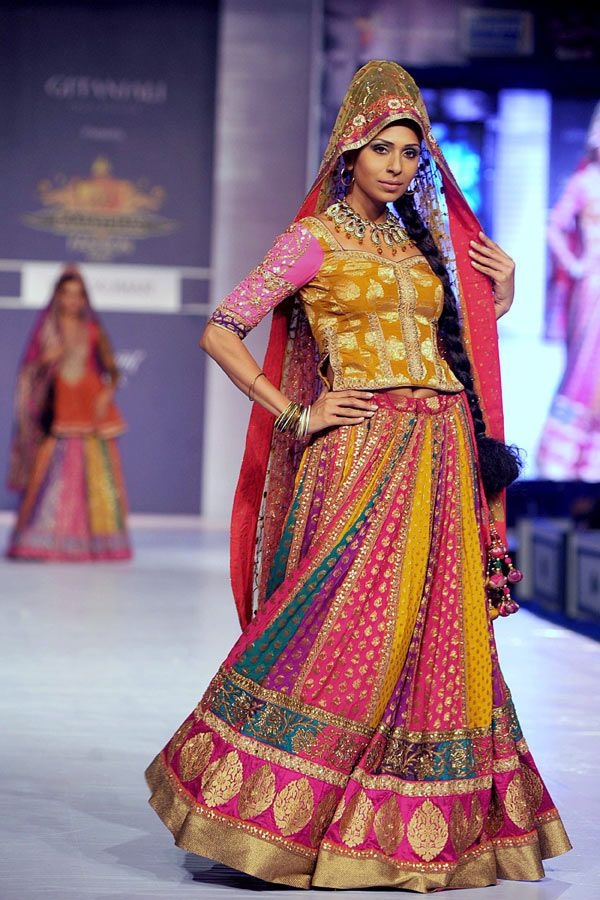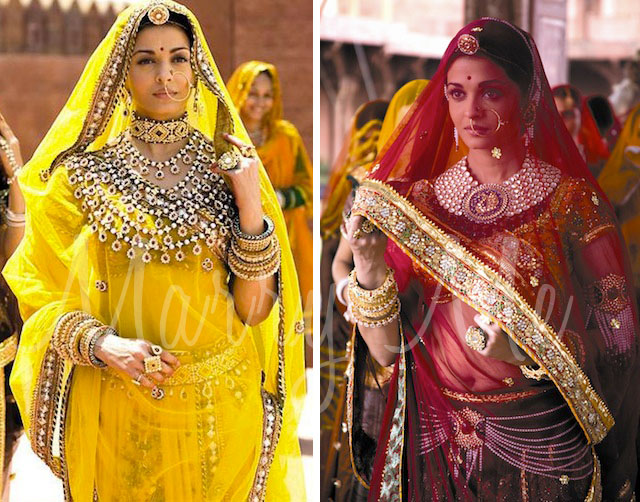
Rajasthani Ghagra
The term ‘Rajasthani Ghagra’ evokes images of bright swirling colours in the desert radiant with mirrors, with the background of decorated camels, the valour and hospitality of Rajputs, and the art and crafts of Rajasthan.
The Rajasthani Ghagra is a kind of pleated skirt that is long and embroidered and worn as the lower portion of a Ghagra kanchli or Choli (blouse). It is tied around the waist and held by a drawstring. It evolved from Bhainivasani, which has its roots in the Antariya.
This traditional clothing of Ghagra and Choli is worn by women in Rajasthan, Gujarat, Madhya Pradesh, Bihar, Harayana, Himachal Pradesh, Uttar Pradesh and Uttarakhand. The fabrics used are cotton, silk, khadi, georgette, crepe, net, satin, brocade and chiffon. Silk and cotton are the favoured materials.
Origin and History
The history goes back to the 5th or 6th century A.D. Garments similar to the Ghagra can be seen in Buddhist sculptures and paintings dating from the Kushana or early Gupta period – the archetype of the modern Ghagra.
Its can be traced back to the courts in the Mughal era, showcasing Indian culture and arts. The length of the Ghagra which earlier skimmed the floor has been shortened to grace the ankles. A favourite for all kinds of formal and religious occasions, the choli or blouse has detailed patch work. This in turn is designed with beads, fancy stitches, shells, and sequins, the motifs commonly used are of birds, animals, and flowers. Handmade Ghagras are classic.
All over India the it is still the preferred garb in places like Gujarat and Rajasthan. The Rajasthani women were content with embroidery and mirror work whereas the women in royal palaces added gold and silver zari, precious and semi- precious stones to the Ghagra. The fabrics favoured by royalty were brocade, satin and tanchoi.
Other names include Amsuka, Ambara, Antariya and Jaghanamsuka.
Present Day Scenario
The graceful and intricate work is done by hand. The fabric is cut into panels and stitched according to the style, the motifs, embellishment. Materials like georgette, net and crepe are popular today. It takes least 20 days to get it stitched.
Varieties
It is known and worn for its rich craftsmanship and exquisite embroidery, patterns and vibrant colours. The art used in the making are work like: Gota, Phulkari, Shisha (mirror work), Zari, Zardozi, Nakashi, Kundan and much more. Worn during the festival of Navratri, the Shisha or mirror work is combined with patchwork and sometimes stitched on a yoke. For weddings and formal occasions, it is embellished with pearls, silk, sequins and zari.
They are available in different cuts. The circular Ghagra as the name suggests has a wide circumference and rich to look at. The A- line Ghagra is cut in an A- shaped flow and hugs the wearer, ideal for curvaceous women. The straight cut Ghagra is flows down in a parallel shape and is suitable for brides. Varieties like the Sea food tail lehengas, Mermaid lehengas, Paneled lehengas, Kali Ghagras lehengas, Kalidar, A-line lehengas, Lehengas with full flair and many others.
Innovations
Today the dupatta which complements this attire is made of a silk filled duvet and linen from chiffon. The more popular styles are:
The Kalidar – with numerous vertical pleats triangular in shape. These triangles are then stitched together to flare at the hem. The predominant color used is red and orange.
The Pat Ghagra – there is several rectangular panels of material sown together with knife pleats at the waist to give a full look to the skirt. It has heavy metal ornamentation along the borders made in satin and silk.
The Kalipatta Ghagra is a fusion of the Kalidar Ghagra and a straight length of fabric. This comfortable to wear and commonly worn by the Jat, Bishnoi and Rajputs in Rajasthan. The Kalipatti is lighter than a Kalidar Ghagra and more affordable.
Global Appeal
It is popular in India and abroad for its ability to be adapted with international fashion. The Choli is sometimes replaced with a jacquard bustier. It is a popular choice among young adults at college dances too. There is a great deal of interest in making it a part of one’s trousseau.
Wearing the attire
Ghagra, Choli and dupattas are worn during festive occasions such as Diwali, Eid, Dusshera and events like parties, weddings, receptions and ceremonies associated with it.
Silk a strong natural fibre is used being cool in summer and warm in winter. It is an admired fabric of exporters. Satin another contender has varieties such as bridal satin, faille satin, moleskin and antique satin. Light fabrics like these are suitable for Ghagras.
Maintenance
Ghagras that are multi coloured, heavily embroidered and stitched with mirrors, shells or precious stones have to be dry cleaned every time, aired from time to time and stored away from sunlight in a cool dry place. More affordable, light Ghagras can be hand or machine washed separately as they have bright colours that could spread on other garments. The Ghagra has to be ironed indirectly with another fabric or paper in between.
Interesting Facts and Comparisons
- The most voluminous Ghagra could be made from about 20 metres of cloth.
- The design of the Ghagra indicated the social status of women
- The flare of the colourful Ghagra has inspired the works of poets, singers and painters. Phrases such as gherdaar, ghumedaar, kali kalime gher are expressions used to describe the beauty of the Ghagra.
- Georgette lehenga/ Ghagra Cholis are famous in the Hindi film industry and any hit movie be it a historical or modern story has featured the gorgeous Ghagra and Choli.
Reference
Categories: Attires, Clothing Styles & Drapes

